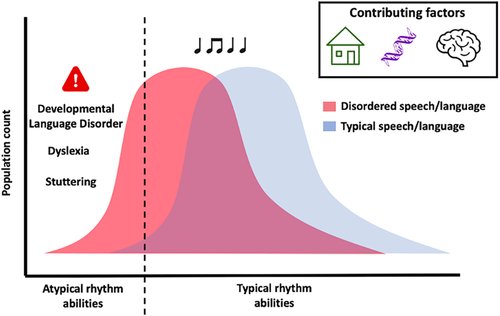Thrilled to announce our new paper published in @WIREs_Reviews, “Is atypical rhythm a risk factor for developmental speech and language disorders?” https://doi.org/10.1002/wcs.1528">https://doi.org/10.1002/w... w/ @EnikoLadanyi @v_persici @Anna5ash @btill_lyon framing the Atypical Rhythm Risk Hypothesis... (1/n)
The Atypical Rhythm Risk Hypothesis posits that individuals with atypical rhythm are at higher risk for developmental speech/language disorders. The paper reviews the literature informing the ARRH and outlines a series of predictions for future studies testing the ARRH. 2/n
First, we present models on shared rhythm and speech/language processing. Fine-grained auditory processing, oscillatory brain networks and sensorimotor coupling as well as hierarchical processing are discussed as mechanisms underlying rhythm and speech/language processing. 3/n
Then Section 3 summarizes research on associations between rhythm and speech/language skills and Section 4 gives a comprehensive review of work showing atypical rhythm skills in children with speech or language disorders including dyslexia, DLD, stuttering, DCD and ADHD. 4/n
Section 5 reviews work on infants’ fine-grained auditory processing, oscillatory brain networks and sensorimotor coupling and results on associations between these functions and later speech/language development. 5/n
The final section of the paper elaborates the Atypical Rhythm Risk Hypothesis, proposing that impaired timing/rhythm skills can serve as a risk factor in the prediction of speech/language disorders, in combination with other risk factors both known and still to be determined. 6/n
The hypothesis is framed within the larger epidemiological literature in which recent advances
(such as genetic correlations with LD Score Regression or Polygenic Risk Scores) allow for large-scale testing of shared underlying biology across clinically distinct disorders. 7/n
(such as genetic correlations with LD Score Regression or Polygenic Risk Scores) allow for large-scale testing of shared underlying biology across clinically distinct disorders. 7/n
Given the high prevalence of speech/language disorders in the population and gaps in identifying children at-risk, research motivated by the ARRH could potentially positively impact access to early identification and treatment. #SLPeeps 9/n
Deep appreciation to the #NIHHighRisk program at @NIH_CommonFund, @NIDCD, and @NSF for funding this project and several of our ongoing studies that test the predictions of the Atypical Rhythm Risk Hypothesis! Thanks also to @VanderbiltENT for ongoing institutional support! 10/n
I am incredibly excited about these new lines of #musicscience research focused on rhythm and speech-language development! An enthusiastic shout-out to co-1st authors @EnikoLadanyi @v_persici & collaborators @btill_lyon @Anna5ash : we had so much fun creating this together! 11/n
Very excited for next steps: to test the Atypical Rhythm Risk Hypothesis from many angles, with multitude of collaborators incl. @ProfSimonFisher @NancyGenetics , Else Eising, Dan Gustavson, @piperbelow, Rachana Nitin @miriamlense and many more! 12/n

 Read on Twitter
Read on Twitter


